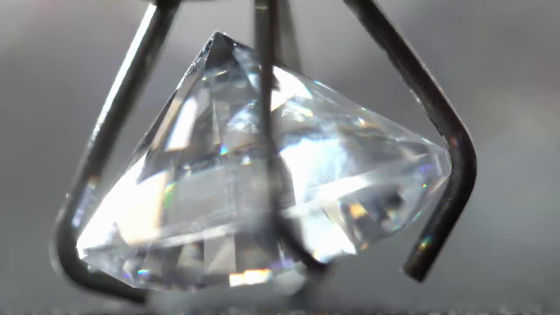A method to make diamonds from crude oil at lightning speed is developed

Known as the hardest substance in nature, diamond is not only known as an expensive gemstone, but also used in industries such as electronic parts, glass, and tools for grinding and polishing, making it an indispensable material for civilized society. . However, the drawback was that producing synthetic diamonds was extremely time-consuming. A research team at Stanford University has announced a technology that can instantly create such artificial diamonds from crude oil-derived substances.
Facile diamond synthesis from lower diamondoids | Science Advances
Modern Alchemy: Stanford Finds Fast, Easy Way to Make Diamonds – “Cheating the Thermodynamics”
https://scitechdaily.com/modern-alchemy-stanford-finds-fast-east-way-to-make-diamonds-cheating-the-thermodynamics/
Stanford scientists turn fossil fuel molecules into pure diamond
https://newatlas.com/materials/synthetic-diamond-stanford-fossil-fuel-molecule/
Diamonds are made from carbon molecules that have crystallized by being exposed to high temperatures and pressures over hundreds of millions of years near the mantle deep underground. Diamonds formed near the mantle are lifted close to the surface by volcanic eruptions, and due to a sudden temperature drop, they appear within the reach of humans in the form of igneous rock called ` `kimberlite .'' Because of this unique production process, diamonds are difficult to obtain and have been treated as valuable ores.
In 1954, American researchers succeeded in synthesizing artificial diamonds for the first time in history using a device capable of generating over 10 gigapascals at 2000 degrees Celsius. Later, the chemical vapor deposition (CVD) method was devised to synthesize diamonds with higher purity, and as technology progressed, humans became able to synthesize artificial diamonds that were comparable to natural diamonds. You can learn more about the history and how to make man-made diamonds by reading the article below.
How to make artificial diamonds that are indistinguishable from natural ones - GIGAZINE

However, conventional methods require nickel, cobalt, and iron as catalysts to promote crystallization. Also, although it is much shorter than hundreds of millions of years, synthetic diamonds take days to weeks and consume large amounts of electricity. Therefore, the challenge has been to develop a method that can further reduce the manufacturing cost of artificial diamonds.
A research team at Stanford University focused on a substance called triamantane , which is refined from crude oil. Triamantane is a powdered substance composed of carbon and hydrogen, and is a type of diamondoid whose molecular structure closely resembles the crystal structure of diamond. The research team conducted experiments by placing triamantane in a pressurized device called a diamond anvil cell and subjecting it to various temperature and pressure conditions.
Then, under conditions of approximately 626 degrees Celsius and 20 gigapascals, the hydrogen atoms contained in triamantane were removed, the carbon atoms aligned, and an extremely pure artificial diamond was synthesized in an instant. Conventional synthetic diamond synthesis requires several steps before a carbon atom becomes diamond, but the method discovered by a research team at Stanford University not only converts triamantane directly into diamond, but also involves the process of synthesis. The time it took was only 19 microseconds (19 millionths of a second).

However, the artificial diamonds produced from triamantane in this experiment were very small, and at the time of writing, it was not possible to synthesize large artificial diamonds that could be used for jewelry. Wendy Mao, a professor of geological science at Stanford University, said, ``This experiment was conducted in a laboratory, and is not practical.'' 'It has been clarified,' he commented.
If this technology can be applied, it is expected that the cost of synthesizing artificial diamonds will drop dramatically, and that artificial diamonds will be used in a variety of fields such as medicine, bioengineering, and quantum computing. Yu Lin, lead author of the paper, said, ``If we can make even a small amount of pure diamonds, we will be able to produce pure diamonds for different purposes.''
Related Posts:
in Science, , Posted by log1i_yk







